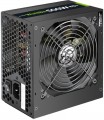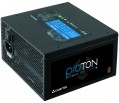PFC
The type of power factor correction (PFC) provided in the power supply.
The power consumed by the PSU is divided into
active and reactive; the first goes to perform useful work, the second does not produce such work and is dissipated in the form of heat. The power factor is the ratio of active power to the total power consumed; the closer it is to one, the more efficient the PSU.
PFC correction is applied to improve the power factor. It can be done passively or actively. The first option provides the presence of a coil (choke), which partly compensates for the operation of the reactive components of the PSU; such a correction is simple and inexpensive to implement, but not very effective. The active method, in turn, provides the presence of a specialized controller. It is more expensive, but the power factor in such PSUs can reach 0.95 or more; in addition, the device is more resistant to voltage drops.
In general, for use in a home or small office, passive correction is more than enough; active PSUs should be specifically looked for mainly in cases where we are talking about numerous computers connected to a powerful UPS.
Efficiency
Efficiency, in this case — the ratio of the power of the power supply (see "Power") to its power consumption. The higher the efficiency, the more efficient the power supply, the less energy it consumes from the network at the same output power, and the cheaper it is to operate. Efficiency may differ depending on the load; the characteristics can indicate both the minimum efficiency and its value at an average load (50%).
It should be noted that compliance with one or another level of 80PLUS efficiency directly depends on this indicator (for more details, see "Certificate").
Fan bearing
The bearing is the piece between the rotating axle of the fan and the fixed base that supports the axle and reduces friction. The following types of bearings are found in modern fans:
— Sliding. The action of these bearings is based on direct contact between two solid surfaces, carefully polished to reduce friction. Such devices are simple, reliable and durable, but their efficiency is quite low — rolling, and even more so the hydrodynamic and magnetic principle of operation, provide much less friction.
— Rolling. They are also called "ball bearings", since the "mediators" between the axis of rotation and the fixed base are balls (less often — cylindrical rollers) fixed in a special ring. When the axis rotates, such balls roll between it and the base, due to which the friction force is very low — noticeably lower than in plain bearings. On the other hand, the design turns out to be more expensive and complex, and in terms of reliability it is somewhat inferior to both the same plain bearings and more advanced hydrodynamic devices. Therefore, although rolling bearings are quite widespread nowadays, however, in general, they are much less common than the mentioned varieties.
— Hydrodynamic. Bearings of this type are filled with a special liquid; when rotated, it creates a layer on which the moving part of the bearing slides. In this way, direct contact between hard surfaces is avoided and friction is significantly reduced compared to previous...types. Also, these bearings are quiet and very reliable. Of their shortcomings, a relatively high cost can be noted, but in fact this moment often turns out to be invisible against the background of the price of the entire system. Therefore, this option is extremely popular nowadays, it can be found in cooling systems of all levels — from low-cost to advanced.
— Magnetic centering. Bearings based on the principle of magnetic levitation: the rotating axis is "suspended" in a magnetic field. Thus, it is possible (as in hydrodynamic ones) to avoid contact between solid surfaces and further reduce friction. Considered the most advanced type of bearings, they are reliable and quiet, but expensive.
Certification
The presence or absence of an 80+ certificate for the power supply. This certificate indicates high energy efficiency: to obtain it, the efficiency (see above) must be at least 80%, and in different modes (20%, 50% and 100% of the maximum load). There are several degrees of 80+:
—
80+. The original version of the certificate, assuming an efficiency of at least 82% (at least 85% for 50% load).
—
80+ White. The second name of the original 80+ certificate (see above).
—
80+ Bronze — efficiency not less than 85% (for half load — 88%).
—
80+ Silver — respectively 87% (90% for half load).
—
80+ Gold — 89% (92% for half load)
—
80+ Platinum — 90% (94% for half load).
—
80+ Titanium — 94% (96% for half load).
The power factor (see "PFC Type") must be at least 0.9 for the lower levels and at least 0.95 for the Platinum level. Also note that for redundant power used in server systems, the efficiency requirements are somewhat lower.
ATX12V version
A standard for power supplies that supplements the ATX specifications regarding power supply along the 12 V line. Introduced into use since the time of the Intel Pentium 4 processor. In the first series of the standard, the +5 V line was mainly used; from version 2.0, the +12 V line was introduced to fully power the components computer. Also in the second generation, a 24-pin power connector appeared, used in most modern motherboards.
SATA
The number of SATA power connectors provided in the PSU.
Nowadays, SATA is the standard interface for connecting internal hard drives, and it is also found in other types of drives (SSD, SSHD, etc.). Such an interface consists of a data connector connected to the motherboard, and a power connector connected to the PSU. Accordingly, in this paragraph we are talking about the number of SATA power plugs provided in the PSU. This number corresponds to the number of SATA drives that can be simultaneously powered from this model.
MOLEX
The number of Molex (IDE) connectors provided in the design of the power supply.
Initially, such a connector was intended to power peripherals for the IDE interface, primarily hard drives. And although the IDE itself is completely obsolete today and is not used in new components, however, the Molex power connector continues to be installed in power supplies, and almost without fail. Almost any modern PSU has at least
1 – 2 of these connectors, and in high-end models this number can be
7 or more. This situation is due to the fact that Molex IDE is a fairly universal standard, and with the help of the simplest adapters, components with a different power interface can be powered from it. For example, there are Molex - SATA adapters for drives, Molex - 6 pin for video cards, etc.
PCI-E 6pin
The number of 6-pin (6pin) PCI-E power connectors provided in the power supply.
Such connectors are used for additional power supply of those types of internal peripherals for which 75 W is no longer enough, supplied directly through the PCI-E socket on the motherboard (video cards are a typical example). The 6-pin connector on the power supply additionally provides another 75 W — thus, when using this connector, it becomes possible to connect boards with a power consumption of up to 150 W.
Note that some video cards have several connectors for additional power at once. Thus, the PSU can provide both
one PCI-E 6pin plug, and
two such connectors. However, in general, this type of plug is used quite rarely — this is due to the spread of a more convenient and versatile 8pin connector in the “6 + 2” format, which can be used both as six- and eight-pin (see below for more details).
PCI-E 8pin (6+2)
The number of PCI-E 8pin (6+2) power connectors provided in the PSU design.
Additional PCI-E power connectors (all formats) are used to additionally power those types of internal peripherals for which 75 W is no longer enough, supplied directly through the PCI-E socket on the motherboard (video cards are a typical example). In PC components, there are two types of such connectors — 6pin, providing up to 75 W of additional power, and 8pin, giving up to 150 W. And the 8pin (6 + 2) plugs used in power supplies are universal: they can work with both 6-pin and 8-pin connectors on the expansion board. Therefore, this type of plug is the most popular in modern PSUs.
As for the quantity, on the market you can find models
for 1 PCI-E 8pin (6 + 2) connector,
for 2 such connectors,
for 4 connectors, and in some cases —
for 6 or more. Several of these plugs can be useful, for example, when connecting several video cards — or for a powerful high-performance video adapter equipped with several PCI-E additional power connectors.

